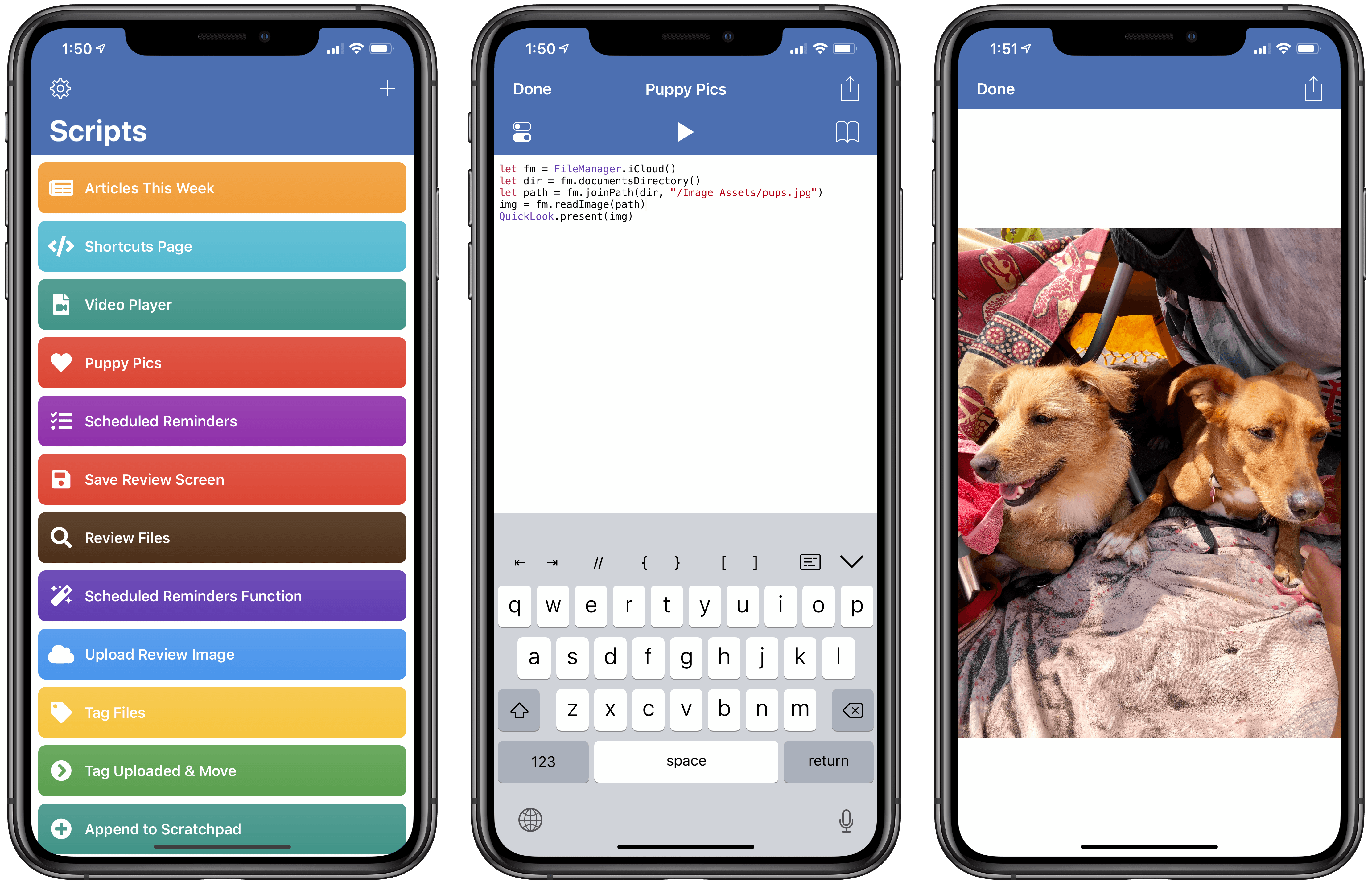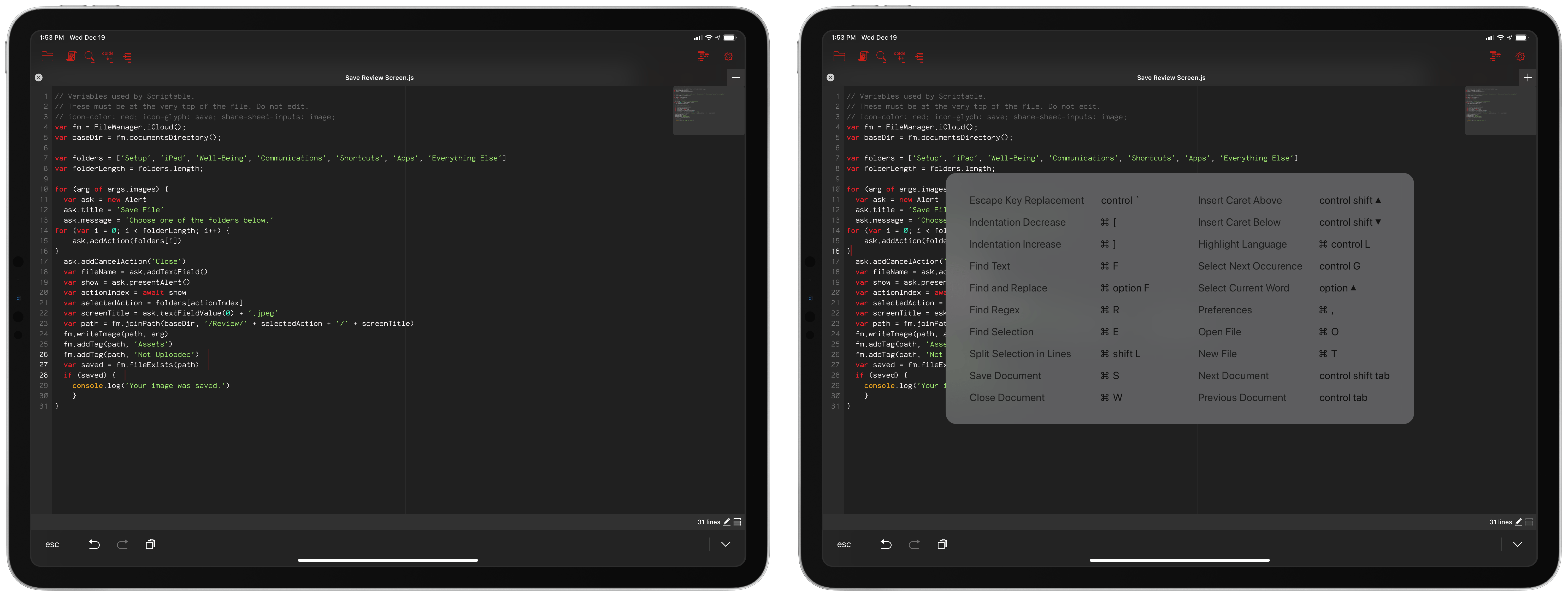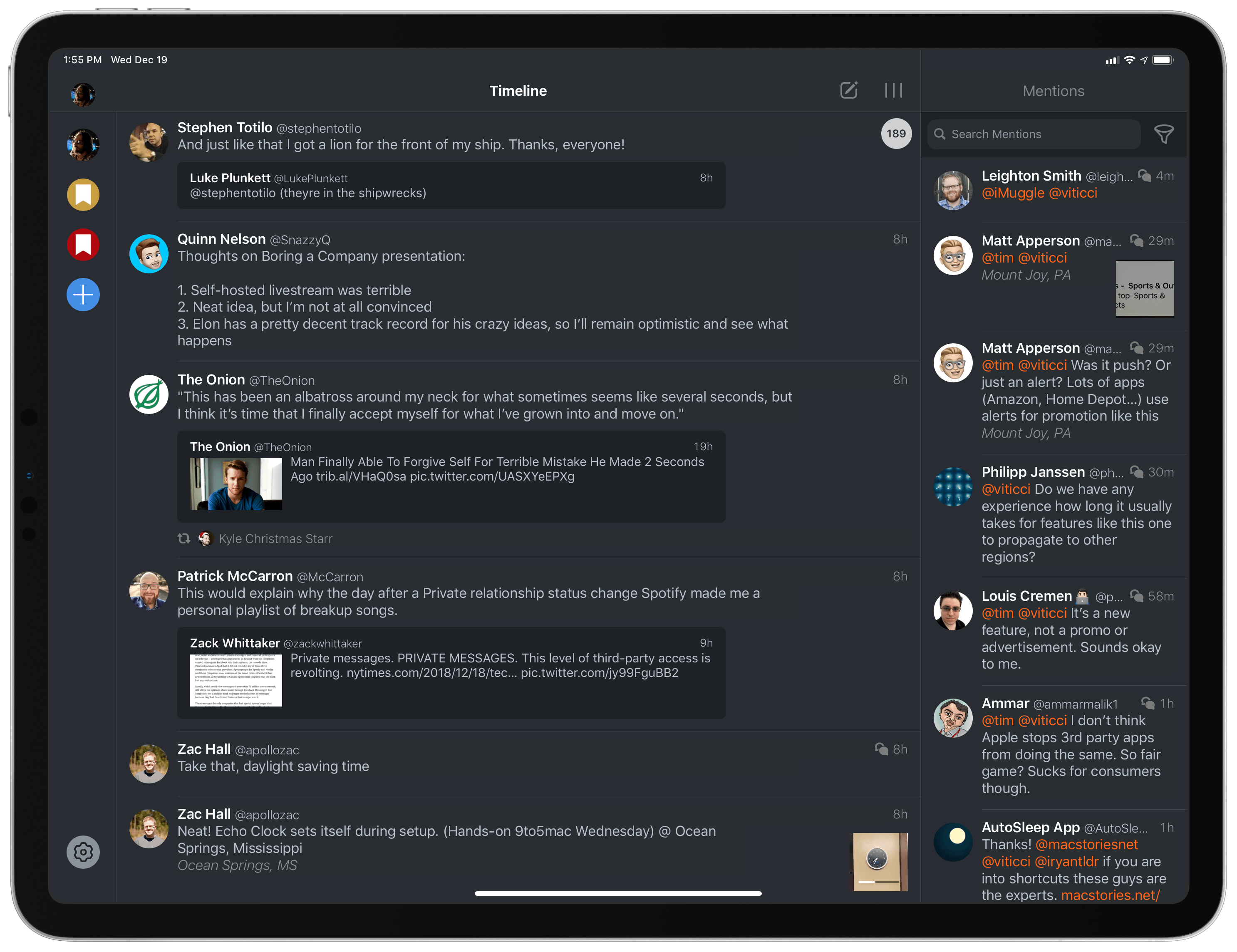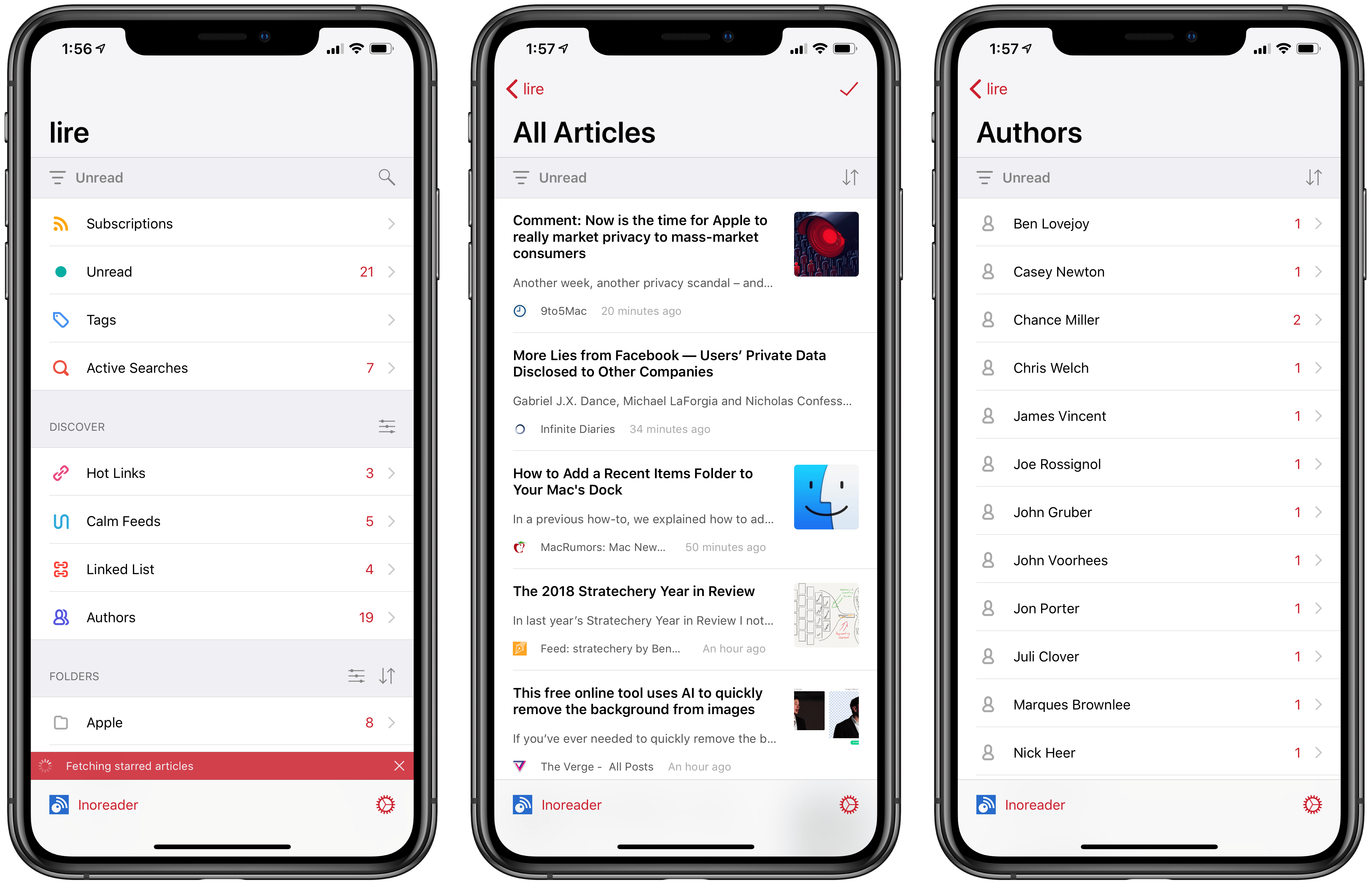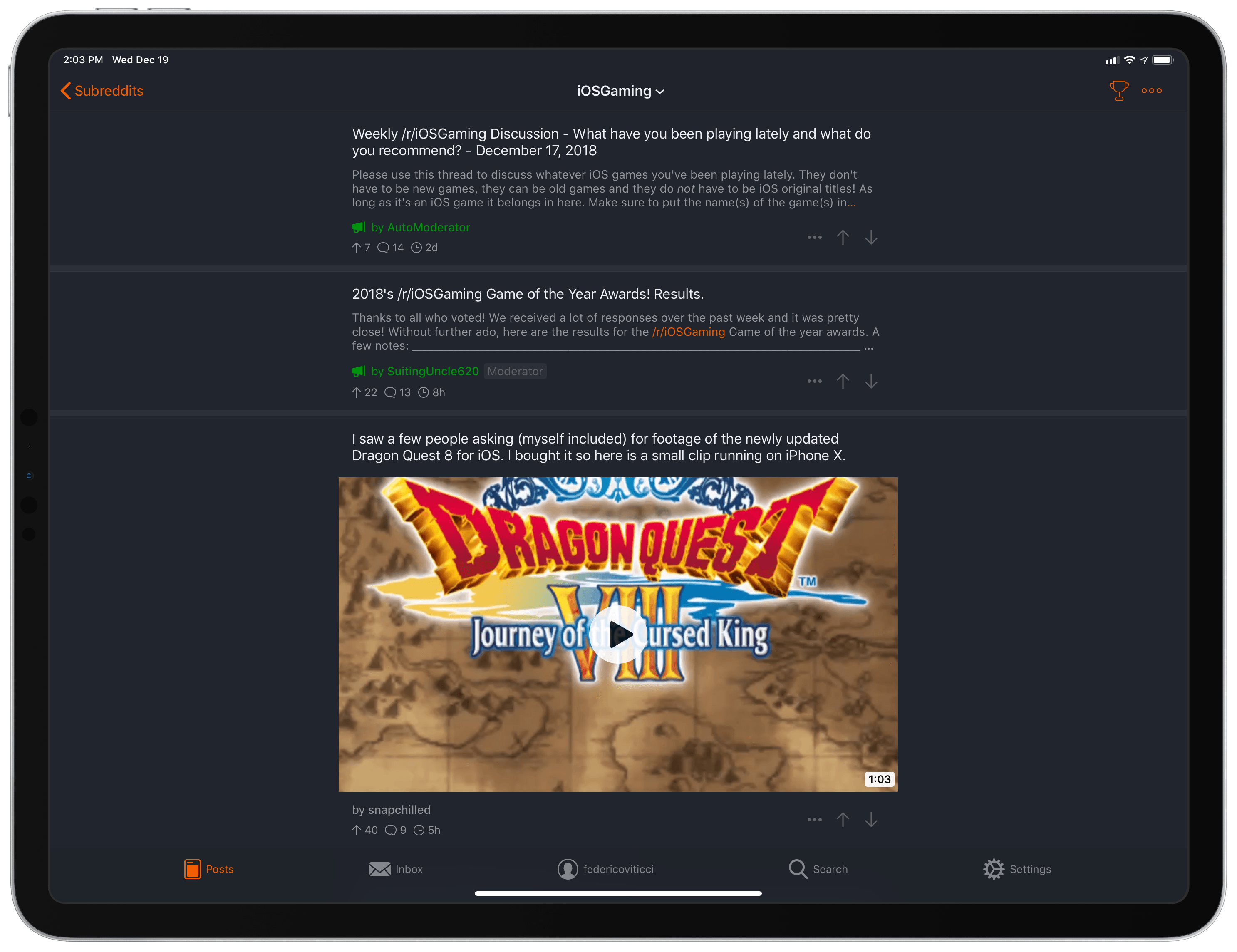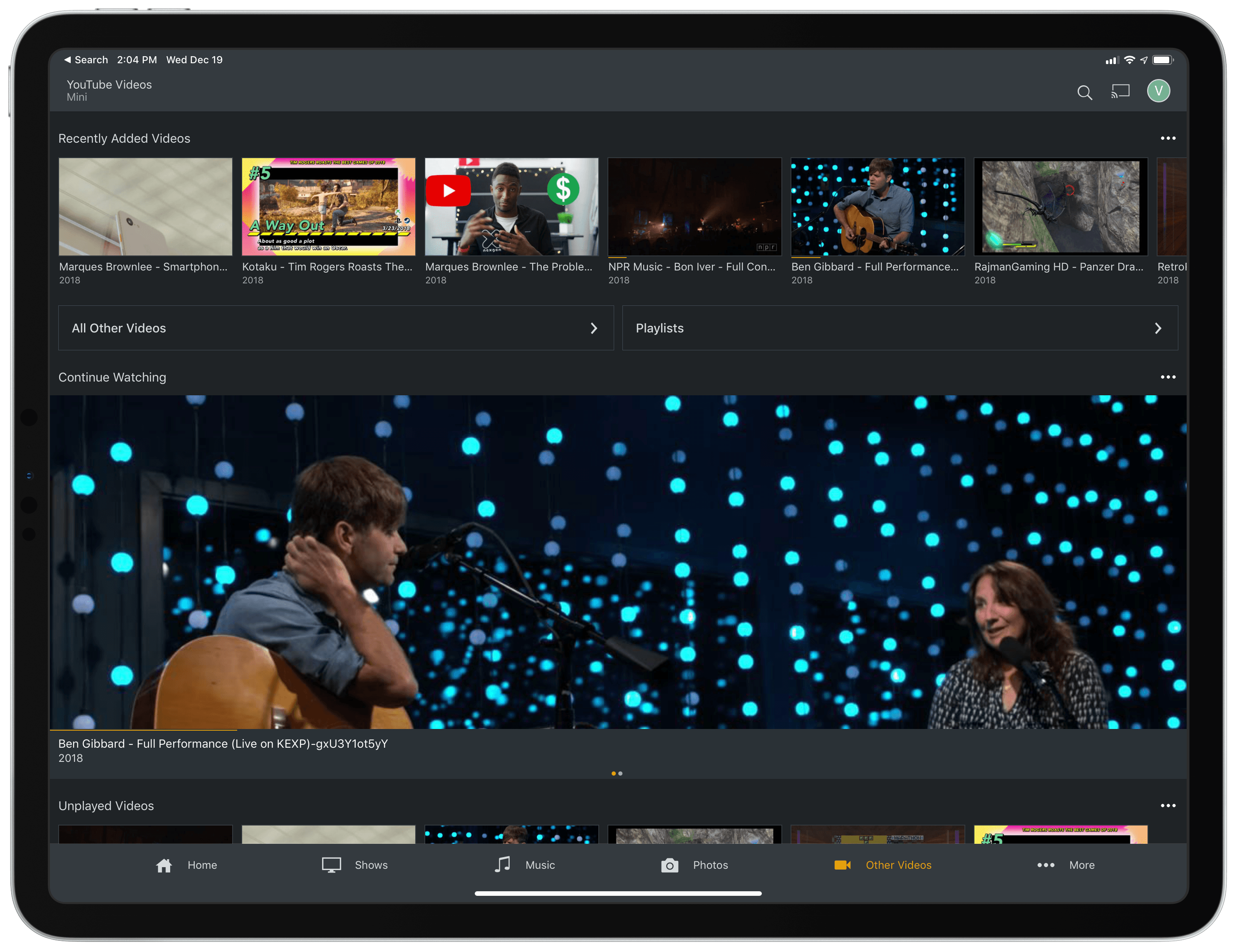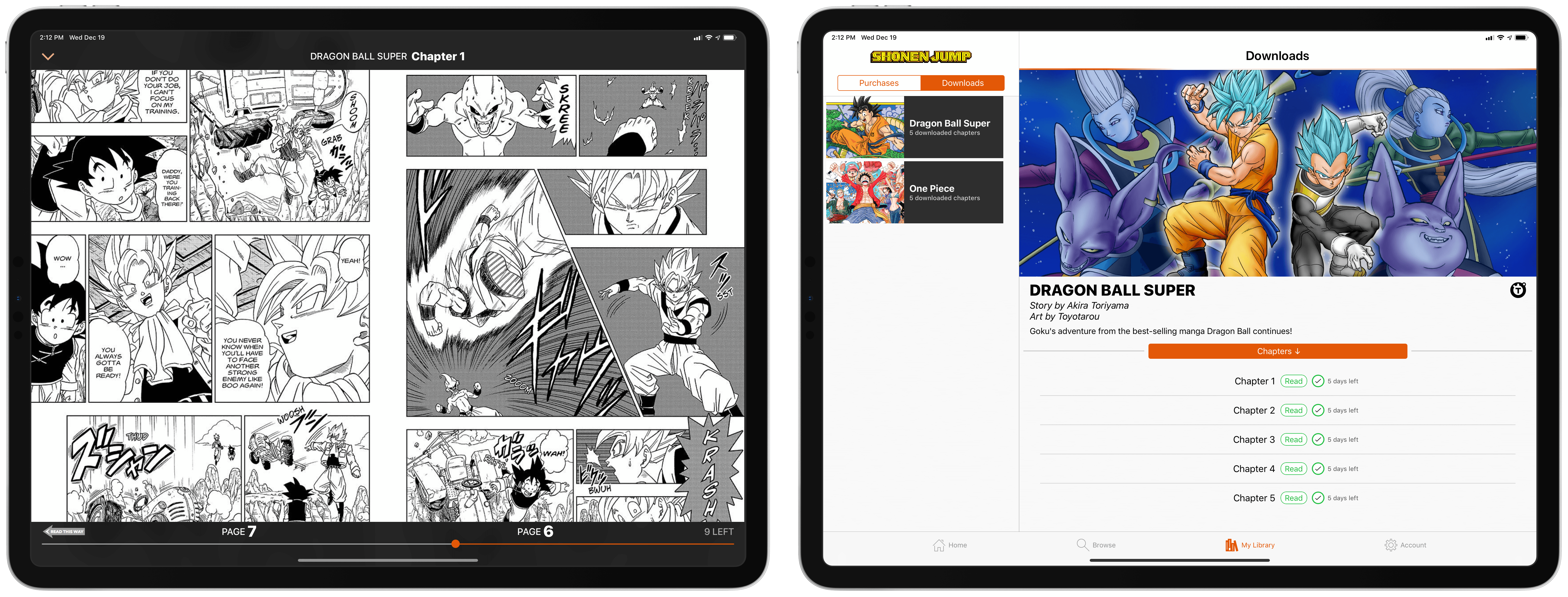Development
Pythonista. After six years, I still turn to Python and Pythonista whenever I want to script something that can’t be automated with Shortcuts. While developer Ole Zorn is working on a major update to Pythonista with support for Siri shortcuts and custom keyboards, the current version of the app works well on iOS 12 and is still compatible with the share sheet for integration with other apps. The biggest advantage of Pythonista is the maturity of Python (the app lets you choose between the Python 2.7 and 3.6 interpreters) and the fact that it lets you install additional packages if you know what you’re doing. I use Pythonista to extract information from the MacStories RSS feed, read the contents of individual actions in a shortcut, and I’m also working on adapting youtube-dl to it. If the app’s next update is as powerful as teased by its developer, I feel like Pythonista will gain a more prominent role in my workflow in 2019. [Review and previous coverage]
Scriptable. Developed by Simon Støvring, Scriptable is what would happen if Pythonista came out in 2018 and worked with JavaScript instead of Python. Scriptable is a JavaScript IDE that lets you create JS programs but also integrate with modern iOS frameworks not supported by Pythonista such as Files, Siri shortcuts, rich notifications, and Safari View Controller. In blending these two aspects, Scriptable is reshaping the iOS automation landscape like only Pythonista and Shortcuts did before.
I use Scriptable to show me specific images and PDF documents in Siri; I created scripts for my iOS 12 review to tag and move hundreds of image files across folders in iCloud Drive; I’ve adapted Python scripts for image uploads to work with Scriptable and its native Files picker. Scriptable is one of the best new apps of 2018, and it speeds up my everyday work like few other apps can.
Prompt. Panic’s command line utility for iOS is my favorite app to SSH into my Mac mini and execute shell commands. Prompt looks pretty (something that can’t usually be said about terminal apps) and integrates with the Panic Sync service, so all your servers and locations will stay in sync between devices as well as Coda on Mac and iOS. I like Prompt because it’s customizable: in addition to changing the app’s color scheme and font size, Prompt lets me create clips for reusable commands that I frequently run on my Mac mini. Plus, the app is available on both the iPhone and iPad and supports the new iPad Pro’s screen sizes.
Kodex. This app has become my default text editor for opening plain text files (of any format) and making quick changes to them. Kodex is special for two reasons. First, it’s heavily inspired by Sublime Text and brings several features of the popular desktop text editor to iOS; Kodex comes with support for multiple cursors, customizable keybindings, a document mini-map, themes, and powerful in-document regex search. Kodex feels like using a mobile version of Sublime on iOS; as someone who used to write in Sublime as his primary text editor years ago, I can tell you – Kodex is an impressive approximation of what a native Sublime Text would look like on iOS.
At the same time, Kodex also integrates with modern iOS APIs in that it’s one of the few apps to support Files’ ‘Open in Place’ mode for documents. To open existing text files, Kodex brings up a Files picker that lets you choose documents from any location in iCloud Drive or third-party apps; once a document has been edited, changes are saved back to the file in its original location without creating a duplicate version. I’ve been using Kodex to make changes to .js files stored in the Scriptable folder in iCloud Drive; I use it to edit long Markdown pieces stored in iA Writer or Working Copy; it’s the app I open every time I have to make changes to a JSON file that provides data to some of my advanced custom shortcuts. If the idea of an iOS version of Sublime Text appeals to you, I can’t recommend Kodex enough.
Social
Tweetbot. One of my goals for 2018 was to spend less time on Twitter every day, and looking back at my stats collected in Toggl, I think I’ve largely succeeded. When I do want to catch up on Twitter and scroll through my mentions, I still use Tweetbot.
In many ways, I consider Twitterrific to be a superior Twitter client because it’s more frequently updated and has more options. However, there’s something about Tweetbot that pushes me back to the app every time I try to switch. I don’t know if it’s because of the fluidity of scrolling the timeline, or perhaps the fantastic two-column layout of the iPad app, but Tweetbot feels like home and it’s the only way I can tolerate using Twitter these days. [Review and previous coverage]
Instagram. Some of the “social time” that I’ve taken away from Twitter has gone into Instagram this year. I’m posting more photos on a regular basis, I’ve started following more people, and I keep up with what my friends are up to thanks to the massive, global adoption of Stories. I’m annoyed by the lack of a native Instagram app for iPad, but that doesn’t change the fact that Instagram feels like a safe haven of inspiration and cute dog portraits where I don’t see news of tragic events or politics every few minutes. I’m not a fan of the company behind Instagram (how can anyone be?), but the people who use the service make it more relaxing and fun than what Twitter has turned into.
Linky. This utility by indie developer Benoît Bourdon has been a must-have for me since the days of iOS 8 thanks to its powerful extension that simplifies sharing text, images, and links to Twitter. The custom tweet sheet of Linky supports syntax highlighting for text and hyperlinks; it comes with auto-completion for usernames; and it supports switching between multiple accounts. The majority of my tweets about MacStories articles are sent with Linky, and I can’t recommend this handy little app enough if you share a lot of screenshots and links every day. [Review and previous coverage]
WhatsApp. There was a time when I would have said “I don’t love WhatsApp, but I have to use it because all my friends are on it”. While I don’t love the company behind WhatsApp (just like Instagram), the app has gotten a lot better in recent months, particularly in the image and audio sharing departments. In many ways, I think WhatsApp is ahead of iMessage, such as when it comes to managing groups or attaching GIFs to conversations. There are other changes I’ve grown to like over time: WhatsApp now brings up a custom contextual menu when long-tapping messages, and it can also play multiple audio messages in a row if a contact sends you multiple voice messages in a conversation. What I said about Instagram is true for WhatsApp as well: there should be an iPad app for WhatsApp – I shouldn’t have to keep my iPhone next to me at all times if I’m writing on the iPad and need to text my girlfriend. Maybe next year.
News
Lire. As a result of cutting down the time I spend on Twitter and Facebook every day, I have turned to good old RSS for my news consumption habits. Lire is my favorite RSS reader for iOS because it’s fast, has fantastic caching controls for full-text extraction and images, and looks native to the iOS platform thanks to its polished design.
This year, lire was updated with a host of useful new discovery features to browse your subscriptions in different ways: lire can now surface “hot links” that several publications have linked to, display “calm feeds” with posts from websites that don’t publish often, and even show you articles from specific authors. Plus, all of these views can be added to Siri as shortcuts. I’ve been enjoying lire for the past couple of years; as an Inoreader user, this client does everything I need and looks great on the new iPad Pro. [Previous coverage]
Apollo. Over the past year, I’ve started visiting a handful of sub-reddits (r/iPad, r/shortcuts, r/iOSGaming, and r/NintendoSwitch, to name a few) both for news related to a specific subject and to engage with the community. Apollo is hands-down the best iOS app to access Reddit and tailor the experience to your needs. There are too many new features to call out individually, but I’d like to highlight filters and notifications.
With keyword filters, browsing a sub-reddit in Apollo is akin to using Tweetbot to curate your Twitter timeline – you can specify topics you’re not interested in and posts containing those keywords will be hidden by Apollo. It’s a great way to hide bug reports from r/iOSBeta, for instance. Notifications are part of the Apollo Ultra package, and they allow you to stay up to date on new posts, comments, and replies thanks to a server-side component that instantly sends push notifications to your iOS devices. I could mention the amazing custom icons, excellent media player, or the jump bar that we selected as one of our favorite app features of 2017, but that still wouldn’t be enough to sum up Christian Selig’s magnificent work. Apollo isn’t just the best third-party Reddit client for iOS – it’s one of the finest news apps currently available on the App Store. [Review]
Entertainment
Overcast. At the beginning of the year, I thought I would spend the rest of 2018 listening to podcasts using Apple’s official app, but Marco Arment’s excellent work on updating Overcast for iOS 12 drove me back to his podcast client again. Thanks to Siri shortcuts, Overcast 5 is just as deeply integrated with iOS and HomePod as the Apple Podcasts app: I can resume playback with a Siri phrase and play specific podcasts or playlists by requesting them with my voice. I even created custom widgets via Shortcuts to start Overcast playback in the background without interacting with Siri at all. These enhancements complement a thoughtful redesign of the Now Playing screen and advanced features that are nowhere to be found in Apple’s app such as Smart Speed, Voice Boost, and, new in version 5.0, full-text search and episode release frequency. The adoption of Siri shortcuts has leveled the playing field between Podcasts and Overcast, which allows me to enjoy the exclusive features of Arment’s app without missing the convenience of Siri. [Review and previous coverage]
YouTube. My YouTube consumption has increased this year thanks to the launch of YouTube Premium in Italy. I can’t imagine going back to watching YouTube ads and having to wait for videos to start; I also enjoy the ability to cache videos for offline watching. I’m not completely happy with the YouTube experience on iOS though: the app still doesn’t support Picture in Picture on iPad (not even for Premium subscribers) and can’t display 4K content natively on iOS. The latter is the result of a disagreement between Apple and Google on which codec to implement – hopefully, the industry’s adoption of the superior AV1 codec will end these divergences once and for all.
iShows TV. My favorite app to track TV shows with trakt.tv integration, Couchy, was discontinued earlier this year. In its place, I’ve started using iShows – a longtime MacStories favorite that doesn’t have the same features of Couchy, but which gets the job done. iShows looks great on the new XS Max and its UI is customizable, so you can change the background color and size of posters embedded within the app. I wish that marking episodes as watched from the main view was a bit quicker, but at least the app has a Calendar view (Premium-only) that shows you upcoming episodes in an easy-to-read list format. [Review]
Plex. As the owner of a new Mac mini that I bought with the intention of setting up a home server, this is an obvious choice. With Plex Media Server running on the Mac mini and scanning folders on external drives for new TV shows, YouTube videos (downloaded with youtube-dl), and music, I can use Plex on my iPad Pro and iPhone XS Max to stream those videos both on my local WiFi network and 4G.
Because I invested in a six-core mini with 16 GB of RAM, I enabled the “Make my CPU hurt” option of the Plex transcoder, which results in the Mac mini’s fans spinning up for a few minutes when transcoding a 4K video that, however, starts playing immediately without stuttering on all of my devices. It’s remarkable what Plex can accomplish with a powerful Mac server. The Plex app for iOS recently gained an experimental video player, which looks nice, as well as new sections on the main page that can be disabled and customized to your needs.
VLC. If all else fails, or if I just need to play a video with a peculiar format without uploading it to my Mac mini first, there’s always VLC. This app can play anything you throw at it, from MKV files to videos streaming from a URL and content stored in your Dropbox account. VLC supports it all, including 4K and HDR content. VLC runs great on the new iPad Pro, supports video-out mode for external displays, and lets you customize the player with custom gestures. I keep VLC on all my devices (including the Mac) because it has never disappointed me over the years.
Shonen Jump. I dreamt of this moment since I was a kid buying manga at his local comic books store. Shonen Jump, Japan’s leading weekly manga publication, has a new iOS app based on a $1.99/month subscription that gives you access to the entire back catalog of Shonen Jump chapters with the added benefit of same-day releases as Japan. If you’re into manga, you know that this is a big deal: you can now read all chapters available in English on Shonen Jump on your iOS device for $2/month and you’re going to find new chapters from the likes of Dragon Ball Super and One Piece as soon as they become available in Japan.
Viz Media, the American company behind the western edition of Shonen Jump, has done a fantastic job bringing the tradition of Shonen Jump into the modern era of iOS apps with subscriptions, making this one of the most exciting app launches of 2018 for me. The new Shonen Jump supports the new iPad Pros and, more importantly, is a major milestone for reading digital manga in a legal fashion outside of Japan.


